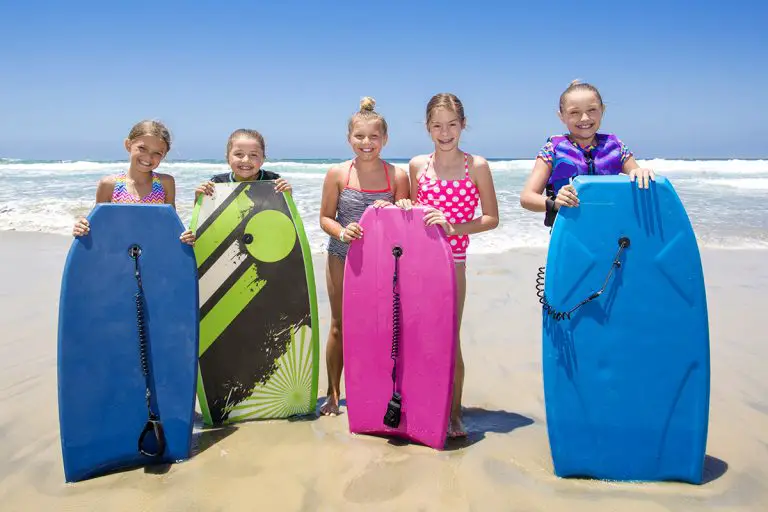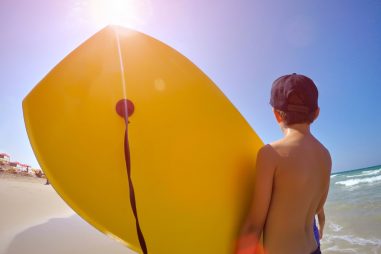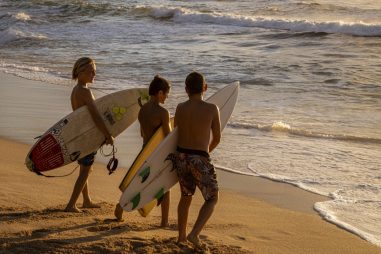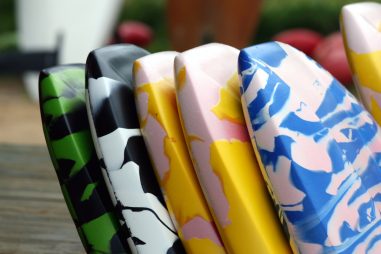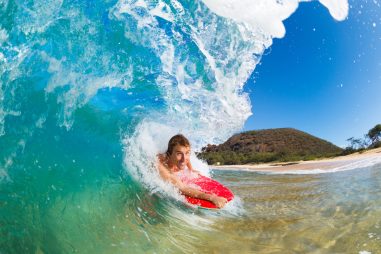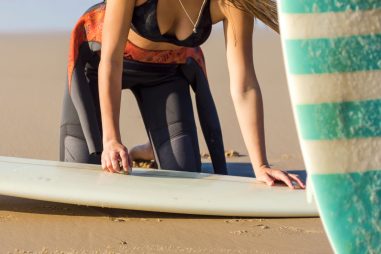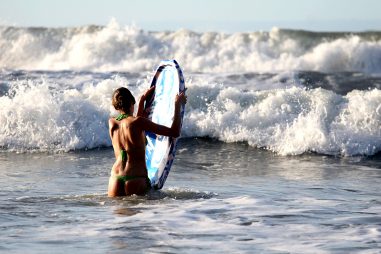It is a huge advantage to learn boogie boarding as soon as the child develops the skill to walk and to swim. There are many boards built specifically for kids of all ages. Teaching boogie boarding is pretty straightforward and does not need a lot of skill. As a safety reminder, kids should always be supervised by an adult when going to the water.
When Can Kids Use Boogie Board?
Kids can start playing with boogie boarding at any age with the supervision of a parent or an adult. Most kids start boogie boarding between the age of three to four years old. Three to four is the age range where a child already learned how to walk and swim. Also, at these ages, kids already develop sufficient physical strength to catch and withstand whitewater.
Boogie boarding or any sports activity has huge physical and mental benefits for a toddler. The majority of the kids enjoy going to the beach and being in the water. Slowly and patiently train them the skill needed for boogie boarding at an early age. Also, remember to let them gain their own interest in the sport.
Is Boogie Boarding Safe for Kids?
There is always a certain risk involved when going out on the beach. That is why kids should always be closely supervised by an adult when boogie boarding, anyone who boogie boards should also be a skilled swimmer. Not all boogie boards come with a leash system, especially the inexpensive types. Bodyboard only away from a shore that you can confidently swim back to.
Observing proper safety precautions and correctly entering and riding waves will reduce injuries for both kid and adult bodyboarders. Inexperience boarders should only ride waves within their skill capabilities. Getting boogie boarding lessons for your kids will help them stay more cautious and safe on the water.
How Do You Choose a Boogie Board for Kids?
Before buying an aesthetically looking boogie board, the first priority is to choose the board that will match your kid’s size. If your child is not with you when buying the board, you can look into boogie board size charts to help you choose the correct board dimensions for your kid.
Boogie board features are also significant in buying a boogie board for kids. Try to look for a board with a leash to help your kid stay connected to the board. After getting the correct boogie board size and features, you can now choose from different available designs for your kid. Boogie boards offer a wide variety of designs, themes, and color schemes to choose from.
How Big Should a Kids Boogie Board Be?
The boogie board size greatly depends on the kid’s height and weight. Make sure to measure your kid’s height and weight before buying a boogie board. Doing this will help you select the most appropriate size for your child. Below is a sizing chart to guide you choose the perfect board for your kid.
| Boogie board size (inches) | Weight (lbs) | Height (inches) |
| Below 30 in | 30 – 45 lbs | 20 – 40 in |
| 30 in | 45 – 55 lbs | 40 – 50 in |
| 32 in | 45 – 65 lbs | 45 – 55 in |
| 34 in | 55 – 75 lbs | 45 – 60 in |
| 36 in | 65 – 100 lbs | 50 – 60 in |
| 38 in | 75 – 130 lbs | 55 – 60 in |
| 40 in | 90 – 160 lbs | 60 – 65 in |
| 40.5 in | 110 – 175 lbs | 60 – 65 in |
| 41 in | 120 – 185 lbs | 65 – 70 in |
| 41.5 in | 130 – 200 lbs | 65 – 70 in |
| 42 in | 145 – 210 lbs | 65 – 70 in |
| 42.5 in | 155 – 220 lbs | 65 – 70 in |
| 43 in | 155 – 230 lbs | 70 – 75 in |
| 43.5 in | 165 – 285 lbs | 70 – 75 in |
| 44 in | 165 – 285 lbs | 70 – 75 in |
| 44.5 in | 175 – 300 lbs | 70 – 75 in |
| 45 in | 175 – 300 lbs | 75 – 80 in |
| 46 in | 185 – 320 lbs | 80 – 85 in |
The table above can serve as a guide for both children and adults. Those figures are only the recommended size, and it is still up to the boogie boarder to choose the size which brings them the most comfort.
How Do You Size a Boogie Board for Kids?
A quick method to know if a boogie board is the right size for your kid is to position the board in front of your child and place the board’s bottom on the ground while holding it straight upward. The top of the board should be at least 1 inch above the belly button of your kid. Using the same method for fast-growing kids, getting a boogie board 2 inches above their navel is advisable.
Make sure the bodyboard is not too large nor too small for your kid. Your kid will have difficulty in holding and controlling the boogie board if it is too big. While very small bodyboard may cause your kid to sink in water. It is also advisable to follow a sizing chart to get more accurate measurements of your child’s height and weight.
What Boogie Board Size Is Best for Kids?
The best boogie board size for your kids greatly depends on their weight and height. To get the most suited board for your kid, pre-measure their weight and height before going out to buy. Here are the standard sizes board sizes for your kids. See the above size chart to get more information on other boogie board sizes.
| Boogie board size (inch) | Weight (lbs) | Height (inch) |
| Below 30 in | 30 – 45 lbs | 20 – 40 in |
| 30 in | 45 – 55 lbs | 40 – 50 in |
| 32 in | 45 – 65 lbs | 45 – 55 in |
| 34 in | 55 – 75 lbs | 45 – 60 in |
| 36 in | 65 – 100 lbs | 50 – 60 in |
For toddlers, you can try looking for specialized boards that offer extra small sizes. These toddler boogie boards usually range from 17 to 25 inches in size. Some also use a kickboard as an alternative for boogie boards for toddlers. The best board is always up to the user if he feels confident using it.
How Do You Ride a Boogie Board for Kids?
Learning to ride a boogie board is pretty straightforward and does not need a tremendous skill. Shallow water with small waves is the perfect spot to practice boogie boarding. Below are some of the steps you can follow when starting to boogie board.
- Choose a spot: If you are practicing with a kid, it is best to start in calm water with minimal waves. It is also important to consider that the waves are appropriate for the child’s age. Choose a spot that is not very crowded, free from stones and other obstacles.
- Wear proper gear: Using the correct equipment for bodyboarding make you more comfortable and safer in water. Swimming clothes like a rash guard, wetsuit, dry suit, swimming trunks, and swimming suit can protect you from heat and cold.
- Use safety features: Most boogie board comes with a leash that you can connect to your wrist. Leashes allow you always to be stay connected to your bodyboard.
- Get in position: It is best to face the white water straight on when getting into your desired water level. Approaching the white water sideways or diagonally is more exhausting and can overturn your boogie board. After getting in your desired water depth, position your board facing the shore and lie on your board.
- Catch the wave: Hold the top of the board with both hands while lying on the board when the wave hits, start to paddle and kick to get back to the shore. Make sure you paddle with both of your hands and keep your feet underwater when kicking.
- Getting back to the beach: Point your board’s nose towards the beach to direct your bodyboard. Continue to kick and paddle if it is still deep enough. Just repeat the process to practice boogie boarding. You may want to catch more challenging waves if your kid feels confident enough.
How Do I Teach My Child to Boogie Board?
It is very easy to teach boogie boarding to kids, even if you don’t boogie board yourself. It is better to get a big board for your kid to have more buoyancy. Here are some tips and tricks to help you groom your kid in boogie boarding.
- Safety first: Before starting bodyboarding, connect the wristband to your kid’s wrist so they won’t lose from their board. Start boogie boarding in a familiar location with small and predictable waves.
- Learn to swim: Anyone who is into board water sports should know how to swim. Swimming is a lifesaving skill and can boost your boogie boarding experience. Make sure your child is a good swimmer before catching bigger waves.
- Choose a spot: It is best to start boogie boarding on shallow water with small waves for beginner boarders. Be mindful of the location of rocks and other obstacles that you may hit when boogie boarding.
- Be patient: While some kids are fearless and confident on the water, some find it threatening and uncomfortable when catching waves. Assess your child’s skills, and don’t rush your kid’s progress. You may want to slow down your teaching pace in certain situations.
- Make it enjoyable: Position your child in an incoming wave. Stay behind your kid’s boogie board, then push when the wave comes. This will make boogie board much easier for them, and they will naturally learn to paddle when the wave comes.
- Ask for feedback: It is important to know how your kids feel in the water and when boogie boarding. Always ask if there is any discomfort, fears, or questions when bodyboarding. Doing this will help them gain more confidence and clear any possible confusion.

